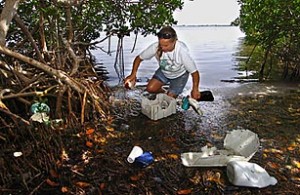from our “oh, swell *&^%” department….R. Charter
http://www.reuters.com/article/idUSTRE65D56I20100614
Offshore drilling backlash may boost shale, oil sands
Alberta (Reuters) – The massive Gulf oil spill may hasten the development of shale gas and oil sands, North America’s two most important emerging energy sources.
The risk of pursuing deepwater oil reserves dwarfs the environmental concerns facing both onshore sectors.
Neither Canadian oil sands petroleum nor natural gas from U.S. shale beds will immediately substitute for delayed Gulf of Mexico crude output in the wake of a six-month drilling moratorium. Still, their development should speed up thanks to the search for less-risky energy sources.
“If offshore development is slower because of this accident, the implication is going to be that the world is going to need supply growth in other areas,” said Jackie Forrest, analyst with energy consultancy IHS CERA in Calgary. “So you might see more growth in oil sands and other sources of global supply.”
Both offer even more promise than the deep waters off the U.S. Gulf Coast.
Alberta’s oil sands are the largest source of crude outside the Middle East, with enough reserves to meet all U.S. demand for 25 years; shale beds beneath many U.S. states could meet the country’s natural gas needs for a century.
Both resources face environmental worries, yet they may be deemed lesser evils compared to the worst U.S. oil spill in history. The spill has officials reconsidering the drive to drill ever deeper in more difficult conditions and should result in tighter and costlier regulations.
“Both shale gas and oil sands have their own challenges but the problems we have seen in the Gulf could lead to a capital shift away from deepwater drilling and toward other sources,” said Robert Johnston, director of energy and natural resources for Eurasia Group in Washington DC.
Whatever the reservations about developing the new fuels, they are attractive as major new domestic energy sources that don’t risk fouling the ocean and would allow the United States to cut its dependence on imported oil, analysts said.
“I would expect to see more development onshore and less offshore,” said Benjamin Schlesinger, president of Benjamin Schlesinger Associates, an energy consultant.
IN SHALE WE TRUST
It’s neither a straight nor clear line from Gulf oil to other forms of energy to the north, yet it is important for energy markets wondering whether fallout from the BP spill will constrain future deepwater oil supply.
Even before the Gulf disaster, U.S. state and federal politicians were urging tighter regulation of shale gas drilling. Environmental groups and some neighbors of shale gas drilling operations fear that ground water is being contaminated with chemicals used in the hydraulic fracturing (“fracking”) process, which extracts the gas from shale a mile or more underground.
A bill in Congress would require drillers to publicly identify the chemicals they use in fracking. Drillers oppose this, saying they are reluctant to disclose proprietary information.
The so-called Frac Act would also give the Environmental Protection Agency (EPA) the option of oversight of the drilling industry, currently regulated by the states.
The EPA is getting ready to conduct a national study of the safety of hydraulic fracturing. State regulators are cracking down on environmental violations in a bid to calm public fears while nurturing a growing industry that already has created thousands of jobs.
Fears over the safety of shale drilling mounted with the blowout of a Pennsylvania well on June 3, prompting state regulators to suspend drilling or fracking by the operator, EOG Resources Inc, amid a drilling boom in the state.
EOG said the cause appeared to be the failure of a seal on the blow-out preventer (BOP), not directly related to the fracking process. Still, the incident should prompt more questions about whether fracking is a safe process that prevents chemical contamination of ground water.
SANDS TAKE TIME
In the oil sands industry, opposition has intensified. Environmental groups such as Natural Resources Defense Council and Greenpeace have mounted campaigns to put the international spotlight on the spread of toxic tailings ponds, high carbon-dioxide emissions and cutting of boreal forests.
Developers say they are working to develop technology to deal with these problems.
High costs and the long lead time for production have limited oil sands development, but it has accelerated with oil prices above $70 a barrel ensuring profitability for key projects. (Graphic: link.reuters.com/fyz89k )
Alberta’s energy regulator said last week that raw bitumen production from Alberta’s oil sands averaged 1.49 million barrels a day in 2009, a 14 percent increase from 2008 — despite a slowdown in planning after prices crashed in 2008.
The Canadian Association of Petroleum Producers said this week that oil sands output could double to nearly 3 million barrels a day by 2020.
Increases in pipeline capacity to the United States and plans to ship large volumes as far as the Gulf Coast were already in place long before the Gulf oil disaster.
Not all analysts were convinced that the Gulf spill would be so positive for oil sands and shale gas development.
“The environmental issues around shale gas pale in comparison with what’s happening in the Gulf,” said Bill Durbin, head of global markets research for the consulting firm Wood MacKenzie.
“But where you already have environmental concerns, those sources may be subject to greater scrutiny and higher costs.”
(Additional reporting by Deborah Zabarenko; Editing by David Gregorio)
Thanks to Richard Charter
